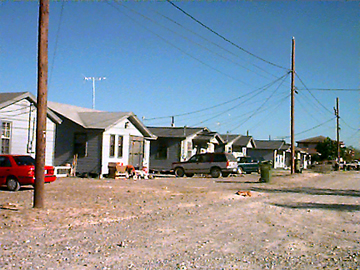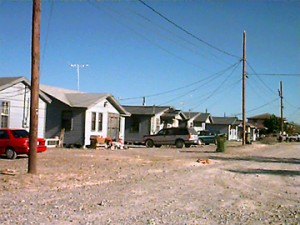Nerd In The Colonia

They were cotton fields located on a floodplain of the Rio Grande. Irrigation canals divided them. Water flowed from the open canal gates soaking the cotton plants. From a black seed, plants bloomed with yellow flowers like an unexpected tulip. Slowly the petals gave way to white fibers. A bushy ball surrounding the seeds waiting ready sail away in the wind, but instead would make ropa. My future home would be located there.
The main cross roads were North Loop Dr. and Moon Road. The area had scattered farmhouses, barns, and casitas for the farmworkers. It was known as Moon City after an old ranchero named Moon. It was an ambitious name, since no city existed much less a pueblo. This changed because another ranchero dreamed of India. Starting in 1960s, a neighborhood, a colonia, arose from those cotton fields. The ranchero subdivided the cotton fields into lots. He named the streets Delhi, Punjab, and Calcutta. Pritam Drive crossed Khalsa Way. Indian names that would soon be pronounced with a Mexican accent. India came to the floodplain. The annual desert monsoons rained on the neighborhood, La colonia ,waiting for future carne asadas.
Moon City had lots, but no houses. There were streets, but no sewers. No gas or water lines. Nothing there except land. It wasn’t required when the ranchero created the lots. Slowly the over the years lots were sold and resold. The majority of the buyers were immigrants with limited income and few resources. Being priced out of rental housing in El Paso, they looked for inexpensive housing options outside the city. Buying a lot and building a casita in Moon City was something they could afford. Since they had no credit, they signed contracts with high interest rates and with the condition they wouldn’t get title to the land until they paid it. If you missed a payment, the seller would repossess the land including the improvements you had made. Regardless, the immigrants looked at Moon City as a place to build a home and a future among the former cotton fields.
It became a colonia of continuous construction. No building codes meant a trailer with a cuartito attached to it was alongside an adobe home with a half-built roof. Construction was based upon the materials the families could gather. They saved every month to buy some bricks and cemeto. If the husband worked construction, he asked the patron for leftover building materials. For some, a room was constructed over a period of months. For others it took far longer. Some lived elsewhere while building the casita, most started building while living there.
A septic tank was dug. A cottonwood tree planted. Some were able to get a water line installed. Many got water from drilling a well then using a pump to put it in buckets to shower and to drink. When a family felt they had finished their homes, they would build some apartamentos in the back yard to rent out. Other lots had two homes where an extended family lived or where two different families lived because the owner had subdivided the lot further.
Each family had different ideas on design and layout of their homes. Doric columns by the front door were popular.. Many half-built homes were painted with clashing pastel colors. Rooms were added, but symmetry in design was a luxury. Additions were added built with a different material plastered with stucco, while the rest of the home was brick. The driveways were mostly on the side of the house, where one of the cars were being salvaged for parts. The front yards had chain fences, since a solid one invited the cholos to tag Moon City Locos on it.
My family lived on Delhi, which everyone pronounced “Dell-Hi.” My parents bought an adobe house from my uncle, which was one of the first home in Moon City. It had no indoor bathroom, just a small room with a shower in the back-yard. It was a home that was poorly constructed. But, it was our home. It had large cottonwood trees that I loved and climbed. Neighborhood kids that I rode my bike with along the Indian streets.
Over the years my parents and siblings learned to paint, do sheet rock, plumbing, roofing and some electrical to fix up the home. We moved the bathroom and shower into the house. The roof was replaced. We put up a fence to keep away the stray dogs always roaming the colonia. Trips the nearest hardware store were a Sabado tradition. It was a constant, never-ending process. It has a humble life, but we knew that the joy was not the same without the pain. We eventually moved after many years. But, when people ask where I’m from, I tell them, “Moon City.” It was my colonia.
Writer, Lawyer, Time-Traveler: Beto Mesta. I am a Latino Nerd living in an American World. Follow him on Twitter: @ElEresNerd
[Photo courtesy University of Texas]

